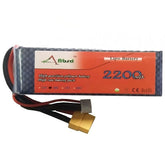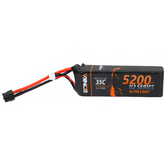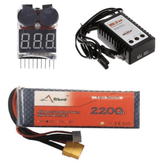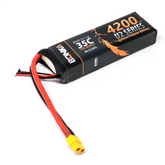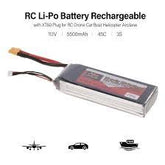Affordable Drone Batteries
Summary
In this blog, we delve deep into the world of drone batteries. From the essential introduction to the various types of drone batteries, we explore the factors that influence battery performance. Discover how to craft budget-friendly DIY drone batteries and maintain them for prolonged use. Whether you're a novice or a seasoned pilot, this guide offers valuable insights into maximizing your drone's potential. Join us as we navigate the skies of affordable drone batteries, ensuring your flights are powered and ready for action. Don't miss out on the secrets to soaring high—read on for an electrifying conclusion!
Introduction
Drone technology has advanced by leaps and bounds in recent years, and as a result, enthusiasts and professionals alike are constantly seeking ways to enhance the performance of their drones. One crucial aspect of this quest for improved flight capabilities is the selection of the right drone batteries. In this blog, we will delve into the importance of drone batteries in enhancing flight performance, with a particular focus on affordable DIY drone battery options.

Types of Drone Batteries
Let's explore the various types of batteries used in drones before discussing affordable DIY drone batteries. These include:
LiPo (Lithium Polymer) Batteries
LiPo batteries or Lithium Polymer batteries are a popular choice for powering DIY drones and UAVs. LiPo battery packs feature high discharge rate cells capable of quick burst discharges to propel your drone up into the sky quickly while also lasting longer than other types of batteries due to deeper cycle life capabilities. The pack's length can be easily customised by cutting off extra cell groups so it perfectly fits your aircraft without losing any performance. Additionally, thanks to its higher voltage ratings over conventional NiMh or Lead Acid products, you can get more efficiency from every gram of propeller thrust available per flight hour! All these benefits make it an excellent option when building DIY Drones on budget that need long-lasting endurance.

Pros:
- High energy density
- Lightweight
- High discharge rate
Cons:
- Sensitive to overcharging and over-discharging
- Requires careful storage and handling
Check out the perfect drone power solution - 2200mAh LiPo Battery!
read more : Working of A Drone
Li-ion (Lithium-Ion) Batteries
Li-Ion batteries or Lithium-ion batteries are a preferred choice for powering DIY drones. They offer higher energy densities than other rechargeable cell types, allowing drones to achieve longer flight times and increased power when used in combination with precision electronic components. Li-ion cells have excellent cycle life, providing reliable performance over extended periods of use time after time. Their lightweight construction also ensures that the drone’s overall weight is minimized while ensuring maximum battery capacity and charging up to full capacity quickly for ready launch anytime you need it most! With state-of-the-art technology integrated into these high-quality lithium-ion batteries from trusted suppliers, let your DIY drone fly effortlessly without experiencing any unexpected surprises in midair!

Pros:
- Good energy density
- Moderate weight
- Longer lifespan compared to LiPo batteries
Cons:
- Lower discharge rate compared to LiPo batteries
Get a rechargeable 3.7V 18650 Li-Ion Battery here!
read more : Drone Motor – Where to Begin?
Also, read our blog on Li-po vs Li-ion Battery
Factors Affecting Battery Performance
Capacity & Voltage
One of the most important factors influencing DIY drone battery performance is capacity and voltage. Capacity measures how much electricity can be stored in a single cell, while voltage determines its performance under different conditions such as temperature and discharge rate. A high-quality lithium polymer (LiPo) battery will typically have a higher capacity than other types of batteries but also generates more heat during charging cycles resulting in increased wear over time leading to decreased longevity.
When selecting LiPo drones for purchase or use, it is important to consider both elements carefully due to their interrelationship; lower voltages require less charge yet are unable to withstand heavy workloads whereas higher voltages deliver better acceleration at the risk of drawing too much current from individual cells which could lead to catastrophic failure if not managed properly by experienced users familiar with advanced electronics hardware engineering principles. Additionally, power management circuitry within each unit should always remain active when using any type of motorized vehicle equipped with these kinds of energy sources even if only operating small models built solely for recreational purposes - this ensures optimal safety & maximizes total flight times available given specific environmental parameters being encountered on an occasional basis throughout usage period intervals designated beforehand prior to take off launch points located near ground zero locations!
read more : How to choose ESC for Quadcopter
Discharge Rates
The performance of a DIY drone's battery is affected by multiple factors, including its discharge rates. Discharge rates determine how quickly the battery drains and are largely influenced by temperature, voltage level, weather conditions and type of activity engaged in. Higher voltages result in faster discharges while lower temperatures allow the battery to last longer between charges. Upgradeable batteries can also improve longevity too!
Affordable DIY Drone Batteries
LiPo batteries are a popular choice for DIY drones due to their affordability, efficiency and weight. Offering an energy density that is up to 8 times greater than NiMH or nickel-cadmium (NiCd) cells - LiPo batteries allow you the freedom of longer flight time with less weight on your drone. Plus, LiPos are resistant to overcharging and feature lower internal resistance levels - allowing them to deliver more power for faster response times without affecting durability or performance in any way.

When choosing a battery type for your drone it’s important that they have enough capacity – usually measured in milliamp hours (mAh). The higher this number is the better quality it will be as it means more stored charge at once – resulting in longer flights without requiring extra charges mid-flight if needed. It’s also essential not only to look at size but balance too; balancing refers to how evenly distributed electrical current flows through all the cells connected together within one pack which affects overall stability and delay during operation when using multiple motors attached together. To ensure maximum performance out of every cell group it's advised each separate motor should include two packs minimum so they can be balanced consequently helping reduce voltage drops while maintaining consistent output across various conditions encountered while flying making sure those challenging aerial manoeuvres remain precise throughout!
Explore the wide range of Lipo Batteries at best prices.
read more : Best flight controller for drone
Battery Maintenance and Care
Drone batteries are essential components, and require diligent maintenance for optimal performance. To prolong the life of your drone battery, ensure you store it in a cool dry place away from direct sunlight and intense heat or cold temperatures -ideally between 10-35°C (50 to 95 °F). Take extra care with charging; use only the recommended power source stated by the manufacturer. Never charge near flammable materials such as gasoline or combustible liquids when around an open fire/flames etc. Check that all cables used are approved for high amperage draw before connecting them to your aircraft’s power system. Do not overcharge or discharge beyond its rated capacity. Periodically inspect FETs on ESC boards looking out for signs of puffing up due to excessive heat generated during operation – if detected replace immediately! Following these simple steps will increase longevity and provide safe reliable flight times each time you take off into fun-filled skies!
read more : Choosing the right propellers for your Drone
Conclusion:
Understanding the world of affordable drone batteries is key to maximizing your UAV's potential. From exploring various battery types to learning about the factors that impact their performance, we've covered a lot in this journey. Don't forget the cost-effective DIY options and the importance of proper battery maintenance. By investing time in this crucial aspect of drone ownership, you not only save money but also ensure longer flight times and safer flights. So, take flight with confidence, armed with the knowledge to power your drones efficiently, and watch your aerial adventures soar to new heights!
If you appreciate our work don't forget to share this post and leave your opinion in the comment box.
Please do check out other blog posts about Popular electronics
Make sure you check out our wide range of products and collections (we offer some exciting deals!)
Frequently Asked Questions
1. Which is better LiPo or Li ion battery for drone?
When it comes to drones, the type of battery you choose is very important. The two most popular options are LiPo and Li-Ion batteries; both have their own advantages when used in an aerial vehicle.
LiPo (Lithium Polymer) batteries hold a higher capacity than most other types of rechargeable cells which allows for longer flight times on your drone. Additionally, they can be discharged at higher rates with minimal voltage drop making them more suitable for delivering power quickly during maneuvering or acrobatic flights as required by racing drones and multirotors alike. On the downside, these require greater care since their internal design makes them prone to explosion if overcharged or short-circuited accidentally - so make sure that built-in safety features such as temperature cut-offs are enabled prior to each use!
Besides being reliable energy sources with ample capacities, one major advantage offered by Lithium Ion batteries lies in their low self-discharge rate compared to NiCad & NiMH packs allowing pilots much greater flexibility regarding prepping time before take off. Furthermore, depending on individual needs due designs may vary from larger blocks featuring male/female connectors typically found between hobby quadcopters all the way down to tiny cylindrical ones specifically designed for smaller consumer-grade nano quads often sporting JST-style connections!
read more : How to build a quadcopter drone at home
2. What is a disadvantage of lithium batteries in drones?
Lithium batteries are a common power source for drones, but they also come with certain drawbacks. These include shorter battery life than other alternatives, such as lead-acid or nickel metal hydride (NiMH) batteries. Additionally, these cells require special charging and storage procedures to avoid shortening their lifespan. Overcharging can potentially cause lithium cells to overheat and cause fires or explosions; therefore it must be monitored carefully when charging remotely operated aircraft that use this type of battery technology.
read more : Assembling the DM002 Drone
3. Which battery is best for homemade drone?
As homemade drones become increasingly popular, it's important to understand the basics of battery selection. The best type of battery for a DIY drone is usually an LiPo (Lithium-Polymer) or LiFePO4 (Lithium Iron Phosphate). These batteries offer high energy density and are relatively lightweight when compared with other types such as NiMH or lead acid cells. They also have better safety features than Nickel Metal Hydride batteries making them ideal for use in unmanned aircrafts projects. When selecting a specific model always make sure you check its capacity rating in mAh (milliamp hour), this will indicate how much power your drone can store per charge so that you can ensure ample flight time without depleting the power supply too quickly!
read more : Drone motor maintenance
LiPo (Lithium Polymer) batteries hold a higher capacity than most other types of rechargeable cells which allows for longer flight times on your drone. Additionally, they can be discharged at higher rates with minimal voltage drop making them more suitable for delivering power quickly during maneuvering or acrobatic flights as required by racing drones and multirotors alike. On the downside, these require greater care since their internal design makes them prone to explosion if overcharged or short-circuited accidentally - so make sure that built-in safety features such as temperature cut-offs are enabled prior to each use!
Besides being reliable energy sources with ample capacities, one major advantage offered by Lithium Ion batteries lies in their low self-discharge rate compared to NiCad & NiMH packs allowing pilots much greater flexibility regarding prepping time before take off. Furthermore, depending on individual needs due designs may vary from larger blocks featuring male/female connectors typically found between hobby quadcopters all the way down to tiny cylindrical ones specifically designed for smaller consumer-grade nano quads often sporting JST-style connections!



